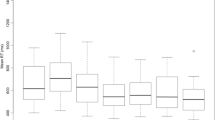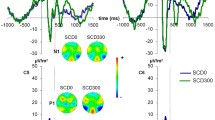Abstract
Simultaneous activation of two sensory modalities can improve perception and enhance performance. This multi-sensory enhancement had been previously observed only in conditions wherein participants were not performing any movement. Since tactile perception is attenuated during active movements, we investigated whether a bi- and a tri-modal enhancement can occur also when participants are presented with tactile stimuli, while engaged in active movements. Participants held a pen-like stylus and performed bidirectional writing-like movements inside a restricted workspace. During these movements participants were given a uni-modal sensory signal (visual––a thin gray line; auditory––a brief sound; haptic––a mechanical resisting force delivered through the stylus) or a bi- or tri-modal combination of these uni-modal signals, and their task was to respond, by pressing a button on the stylus, as soon as any one of these three stimuli was detected. Results showed that a combination of tri-modal signals was detected faster than any of the bi-modal combinations, which in turn were detected faster than any of the uni-modal signals. These facilitations exceeded the “Race model” predictions. A breakdown of the time gained in the bi-modal combinations by hemispace, hands and gender, provide further support for the “inverse effectiveness” principle, as the maximal bi-modal enhancements occurred for the least effective uni-modal responses.






Similar content being viewed by others
References
Angel RW, Malenka RC (1982) Velocity-dependent suppression of cutaneous sensitivity during movement. Exp Neurol 77(2):266–274
Bays PM, Wolpert DM (2007) Computational principles of sensorimotor control that minimize uncertainty and variability. J Physiol 278(2):387–396
Bertelson P, Tisseyre F (1969) The time course of preparation: confirmatory results with visual and auditory warning signals. Acta Psychol 30:145–154
Boulinguez P, Ferrois M, Graumer G (2003). Hemispheric asymmetry for trajectory perception. Brain Res Cogn Brain Res 16(2):219–225
Chapman CE, Bushnell MC, Miron D, Duncan GH, Lund JP (1987) Sensory perception during movement in man. Exp Brain Res 68(3):516–524
Dalton P, Doolittle N, Nagata H, Breslin PA (2000) The merging of the senses: integration of subthreshold taste and smell. Nat Neurosci 3(5):431–432
Diederich A, Colonius H (1987) Intersensory facilitation in the motor component? Psychol Res 49(1):23–29
Diederich A, Colonius H (2004) Bimodal and trimodal multisensory enhancement: effects of stimulus onset and intensity on reaction time. Percept Psychophys 66(8):1388–1404
Diederich A, Colonius H, Bockhorst D, Tabeling S (2003) Visual-tactile spatial interaction in saccade generation. Exp Brain Res 148(3):328–337
Doyle MC, Snowden RJ (2001) Identification of visual stimuli is improved by accompanying auditory stimuli: the role of eye movements and sound location. Perception 30(7):795–810
Duysens J, Tax AA, Nawijn S, Berger W, Prokop T, Altenmuller E (1995) Gating of sensation and evoked potentials following foot stimulation during human gait. Exp Brain Res 105(3):423–431
Forster B, Cavina-Pratesi C, Aglioti S, Berlucchi G (2002) Redundant target effect and intersensory facilitation from visual-tactile interactions in simple reaction time. Exp Brain Res 143(4):480–487
Fort A, Delpuech C, Pernier J, Giard MH (2002) Dynamics of cortico-subcortical cross-modal operations involved in audio-visual object detection in humans. Cereb Cortex 12(10):1031–1039
Frassinetti F, Bolognini N, Làdavas E (2002) Acoustic vision of neglected stimuli: interaction among spatially converging audiovisual inputs in neglect patients. J Cogn Neurosci 14(1):62–69
Frassinetti F, Bolognini N, Bottari D, Bonora A, Làdavas E, (2005) Audio-visual integration in patients with visual deficit. J Cogn Neurosci 17(9):1442–1452
Ghazanfar AA, Maier JX, Hoffman KL, Logothetis NK (2005) Multisensory integration of dynamic faces and voices in Rhesus monkey auditory cortex. J Neurosci 25(20):5004–5012
Giard MH, Peronnet F (1999) Auditory-visual integration during multimodal object recognition in humans: a behavioral and electrophysiological study. J Cogn Neurosci 11(5):473–490
Hershenson M (1962) Reaction time as a measure of intersensory facilitation. J Exp Psychol 63:289–293
Jiang W, Wallace MT, Jiang H, Vaughan JW, Stein BE (2001) Two cortical areas mediate multisensory integration in superior colliculus neurons. J Neurophysiol 85(2):506–522
Kayser C, Petkov CI, Augath M, Logothetis NK (2005) Integration of touch and sound in auditory cortex. Neuron 48(2):373–384
Körding KP, Wolpert DM (2006) Bayesian decision theory in sensorimotor control. Trends Cogn Sci 10(7):320–326
Laurienti PJ, Burdette JH, Maldjian JA, Wallace MT (2006) Enhanced multisensory integration in older adults. Neurobiol Aging 27(8):1155–1163
Lovelace CT, Stein BE, Wallace MT (2003) An irrelevant light enhances auditory detection in humans: a psychophysical analysis of multisensory integration in stimulus detection. Brain Res Cogn Brain Res 17(2):447–453
Mergner T, Rosemeier T (1998) Interaction of vestibular, somatosensory and visual signals for postural control and motion perception under terrestrial and microgravity conditions: a conceptual model. Brain Res Brain Res Rev 28(1–2):118–135
Miller J (1982) Divided attention: evidence for coactivation with redundant signals. Cognit Psychol 14(2):247–279
Miller J (1986) Time course of coactivation in bimodal divided attention. Percept Psychophys 40:331–334
Molholm S, Ritter W, Javitt DC, Foxe JJ (2004) Multisensory visual-auditory object recognition in humans: a high-density electrical mapping study. Cereb Cortex 14(4):452–465
Nickerson RS (1973) Intersensory facilitation of reaction time: energy summation or preparation enhancement?. Psychol Rev 80(6):489–509
Oldfield RC (1971) The assessment and analysis of handedness: the Edinburgh inventory. Neuropsychologia 9(1):97–113
Oliveri M, Rossini PM, Pasqualetti P, Traversa R, Cicinelli P, Palmieri MG, Tomaiuolo F, Caltagirone C (1999) Interhemispheric asymmetries in the perception of unimanual and bimanual cutaneous stimuli. Brain 122(9):1721–1729
Perrault TJ Jr, Vaughan JW, Stein BE, Wallace MT (2003) Neuron-specific response characteristics predict the magnitude of multisensory integration. J Neurophysiol 90(6):4022–4026
Posner MI, Klein R, Summers J, Buggie S (1973) On the selection of signals. Mem Cognit 1:2–12
Post LJ, Zompa IC, Chapman CE (1994) Perception of vibrotactile stimuli during motor activity in human subjects. Exp Brain Res 100(1):107–120
Raab DH (1962) Statistical facilitation of simple reaction times. Trans N Y Acad Sci 24:574–590
Rowland BA, Stanford TR, Stein BE (2007) A Bayesian model unifies multisensory spatial localization with the physiological properties of the superior colliculus. Exp Brain Res 180(1):153–161
Sanders AF (1980) Stage analysis of reaction process. In: Stelmach GE, Requin J (eds) Tutorials in motor behavior. Amsterdam North Holland, pp 331–354
Schmidt RF, Schady WJ, Torebjork HE (1990a) Gating of tactile input from the hand. I. Effects of finger movement. Exp Brain Res 79(1):97–102
Schmidt RF, Torebjork HE, Schady WJ (1990b) Gating of tactile input from the hand. II. Effects of remote movements and anaesthesia. Exp Brain Res 79(1):103–108
Seki K, Perlmutter SI, Fetz EE (2003) Sensory input to primate spinal cord is presynaptically inhibited during voluntary movement. Nat Neurosci 6:1309–1316
Smith EE (1968) Choice reaction time: an analysis of major theoretical positions. Psychol Bull 69(2):77–110
Stein BE, London N, Wilkinson LK, Price DD (1996) Enhancement of perceived visual intensity by auditory stimuli: a psychophysical analysis. J Cogn Neurosci 8:497–506
Sumby WH, Pollack I (1954) Visual contribution to speech intelligibility in noise. J Acoust Soc Am 26:212–215
Todd JW (1912) Reaction to multiple stimuli. Arch Psychol (25):1–65
Ulrich R, Miller J, Schröter H (2007) Testing the race model inequality: an algorithm and computer programs. Behav Res Methods Instr 39(2):291–302
Voss M, Ingram JN, Haggard P, Wolpert DM (2005) Sensorimotor attenuation by central motor command signals in the absence of movement. Nat Neurosci 9:26–27
Wallace MT, Meredith MA, Stein BE (1998) Multisensory integration in the superior colliculus of the alert cat. J Neurophysiol 80(2):1006–1010
Williams SR, Chapman CE (2000) Time course and magnitude of movement-related gating of tactile detection in humans. II. Effects of stimulus intensity on detection and scaling of tactile stimuli. J Neurophysiol 84(2):863–875
Williams SR, Chapman CE (2002) Time course and magnitude of movement-related gating of tactile detection in humans. III. Effect of motor task. J Neurophysiol 88(4):1968–1979
Williams SR, Shenasa J, Chapman CE (1998) Time course and magnitude of movement-related gating of tactile detection in humans. I. Importance of stimulus location. J Neurophysiol 79(2):947–963
Zellner DA, Kautz MA (1990) Color affects perceived odor intensity. J Exp Psychol Hum Percept Perform 16(2):391–397
Zellner DA, Bartoli AM Eckard R (1991) Influence of color on odor identification and liking ratings. Am J Psychol 104(4):547–561
Acknowledgments
This research was funded by the EU research project PRESENCCIA––Presence: Research Encompassing Sensory Enhancement, Neuroscience, Cerebral-Computer Interfaces and Applications. We thank Mr. Gad Halevy for programming the computer for the experiment, and Ms. Ayelet Gal-Oz for her help in collecting the data. We also thank Mrs. Tatiana Gelfeld for her help in the race-model analysis.
Author information
Authors and Affiliations
Corresponding author
Rights and permissions
About this article
Cite this article
Hecht, D., Reiner, M. & Karni, A. Enhancement of response times to bi- and tri-modal sensory stimuli during active movements. Exp Brain Res 185, 655–665 (2008). https://doi.org/10.1007/s00221-007-1191-x
Received:
Accepted:
Published:
Issue Date:
DOI: https://doi.org/10.1007/s00221-007-1191-x




